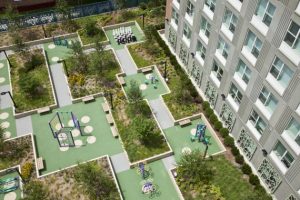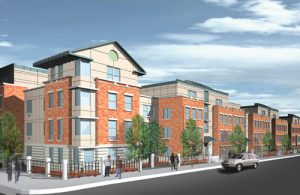Years of research have exposed a direct connection between built environment and residents’ health. Building, street, and neighborhood design is linked with a myriad of physical, social, and mental health problems. These issues are especially common in low income communities and affordable housing developments, which have a higher prevalence of chronic diseases and limited access to healthy food and safe recreation spaces.1 This information, coupled with case studies on successful healthy design initiatives, spurred the “Active Design” initiative in New York City.
Active Design is defined as an “evidence-based approach to development that identifies urban planning and architecture solutions to support healthy communities”.1 NYC’s Center for Active Design works on a variety of initiatives and policies to promote a healthier city structure. One such initiative is Active Design Verified (AVD). AVD recognizes the increased need for such structures in affordable housing, and designs spaces that encourage movement and physical activity. AVD project elements include stairs, bike paths, and on-site exercise facilities for residents.

Outdoor exercise and recreation space at Arbor House. Photo courtesy of Bernstein Associates.
Researchers at Mount Sinai’s Icahn School of Medicine conducted a pilot study to assess the impact of Active Design on resident health. When comparing the tenants in a building with Active Design elements to those in a building without, they found increased rates of stair use, feelings of safety, and belief that their wellness goals were supported among those living in the Active Design facility.
Another ADV initiative, currently underway, is the Prospect Plaza site in Brownsville, Brooklyn. Per the Office of Vital Statistics, Brownsville has the highest death rates of any NYC region, many due to avoidable chronic health conditions. Prospect Plaza seeks to reduce this discrepancy by incorporating several Active Design elements into their 400-unit development, including outdoor exercise areas, gardens with fresh produce, and amenities such as transportation and supermarkets within walking distance.

Site plan sketch for Prospect Plaza in Brownsville, Brooklyn
Once complete, Prospect Plaza will provide a great opportunity for researchers to continue to evaluate the success of Active Design structures and make recommendations for future developments and policies in New York City. With continued efforts, Active Design initiatives can improve the well-being of NYC residents, among communities in need.
Claflin, A., Asri, N., Agarwal, R., Nienaber S. (2017). Understanding the Impact of Active Design in Affordable Housing: Insights for Policymakers and Developers. Center for Active Design. p. 1-6. Retrieved from: http://nyshealthfoundation.org/uploads/resources/center-for-active-design-brief-jan-2017.pdf


